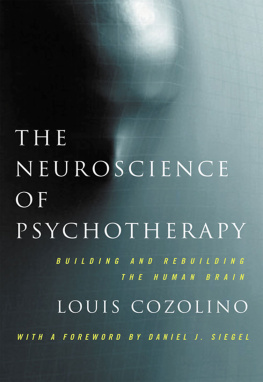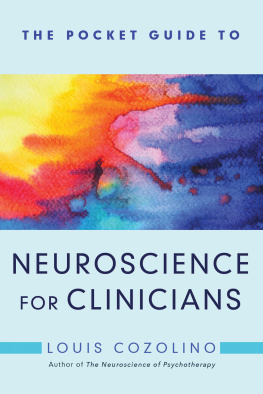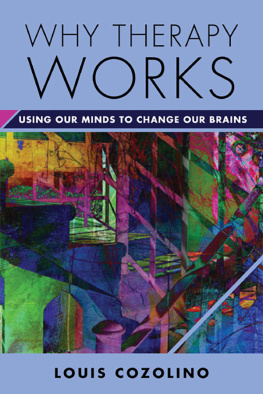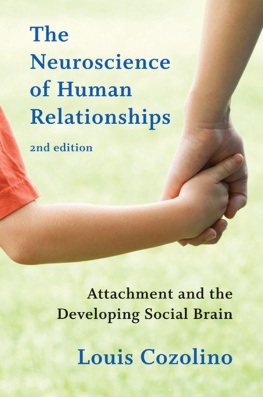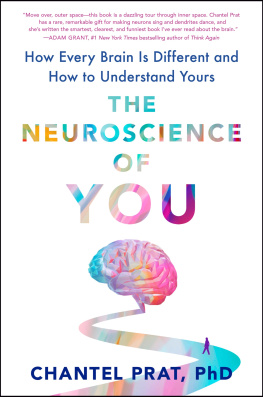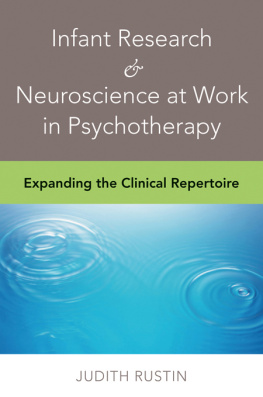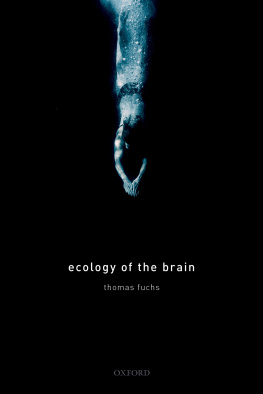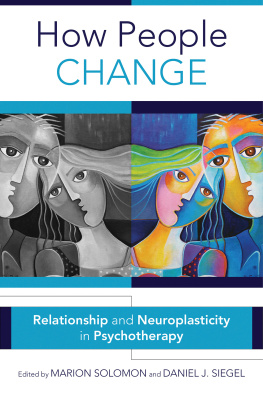The Neuroscience of Psychotherapy
Healing the Social Brain
Second Edition
Louis Cozolino
Foreword by Daniel J. Siegel

W. W Norton & Company
New York London
Unless otherwise noted, figures were created by the author.
Copyright 2010, 2002 by Louis J. Cozolino
All rights reserved
For information about permission to reproduce selections from this book, write to: Permissions, W. W. Norton & Company, Inc. 500 Fifth Avenue, New York, NY 10110
Library of Congress Cataloging-in-Publication Data
Cozolino, Louis J.
The neuroscience of psychotherapy: healing the social brain / Louis J. Cozolino.2nd ed.
p. cm.
Includes bibliographical references.
ISBN 978-0-393-70642-0 (hardcover)
1. Psychotherapy. 2. Neurosciences. 3. BrainResearch. I. Title.
RC480.5.C645 2010
616.89'14dc22
2009043708
ISBN: 978-0-393-70657-4
W. W. Norton & Company, Inc., 500 Fifth Avenue, New York, N.Y. 10110
www.wwnorton.com
W. W. Norton & Company Ltd., Castle House, 75/76 Wells Street, London W1T 3QT
This book is dedicated to my family:
my mothers courage, my fathers determination, and
the memory of my grandparents. Together they somehow
instilled within me the belief that all things are possible.
Foreword
Louis Cozolinos contributions to the Norton Series on Interpersonal Neurobiology have been instrumental in moving this new interdisciplinary field forward. The first edition of The Neuroscience of Psychotherapy inaugurated the series, which now includes 16 titles. With this second edition, Lou has extended and deepened interpersonal neurobiologys basic view that integration is at the heart of well-being. I loved the first edition and have learned a tremendous amount from reading this exciting and extremely accessible updated edition. Readers new to interpersonal neurobiology (IN) will find this a wonderful place to start their journey, as Lou deftly brings the latest in cutting-edge science together with the healing art of psychotherapy. Those familiar with the field will find this a welcome addition to their IN library of texts written with the clinician in mind.
As the founding editor of the IN series, I have been proud to oversee the publication of these books that explore various dimensions of psychotherapy and science. Though each of the individual authors of and contributors may not articulate their work with the same vocabulary, their contributions have all added to the research and clinical synthesis that forms an educational foundation for IN as a multidisciplinary and synthetic way of knowing about what it means to be human. Ours is a complex species: We have inherited a nervous system whose evolution has left us with many mechanisms not suited to modern life. And we live within relationships that have shaped and continue to shape how our social brains are constructed within families, communities, and society. Cultural evolution continues to mold our synaptic architecture, influencing how we experience our inner, subjective lives and learn to communicate with one another.
This complexity could easily make us as clinicians move away from science to approach healing from an intuitive way of knowing alone. My hope in founding the field of IN has been that we would be able to see the forest for the trees, so to speak, and not get distracted by details, with all of their fascinating and nuanced complexities, but rather become enriched by all of this cutting-edge unfolding of new knowledge and ideas. But, this certainly is a challenge. In the busy lives of clinicians (and just plain everyday life), the tremendous amounts of data emerging from ever-expanding fields of science can be daunting. What we are trying to do with the IN series is to provide a forum for those working at the creative boundary between the chaos of overwhelming knowledge and the order of an intellectual framework. Lou Cozolino rides that edge like a master surfer, bringing together emerging findings from neuroscience with the beauty and power of healing relationships. Its a magnificent adventure, and you will need to take a deep breath and hold on as he takes you along with him through the various dimensions of science to see psychotherapy from new and helpful vantage points.
A framework that can be helpful in this important quest views clinical work as involving a triangle of well-being comprising the three points of Mind, Brain, and Relationships. This is a visual metaphor depicting the most foundational dimensions of our human lives, the essence of our subjective and our objective lives. This is a triangle revealing the flow of energy and information. Relationships are how we share energy and information with one another. The brain is here the extended nervous system distributed throughout the entire body, which is a mechanism through which energy and information flows. And the mind, in part, is how that flow is regulatedhow we see and shape energy and information as it moves through our bodies and through our relationships.
Psychotherapy entails shaping these elements of our triangle toward well-being. From the IN perspective, health is achieved by promoting integration in our lives: Our minds come to monitor and modify our internal and interpersonal worlds toward the linkage of differentiated elements. The mind is a process that is both embodied and relational. In this view we can use our minds to cultivate integration, which promotes harmony; the lack of integration leads to chaos or rigidity. From the IN standpoint, we can see, for example, the various psychiatric symptoms and syndromes as revealing the chaos and rigidity that emerge from impairments to integration. Clinical assessment can detect when chaos and rigidity are present and identify the neural or interpersonal domains in which integration is lacking. Focusing on the need to enhance differentiation and promote linkage, an IN clinician is offered the framework with which to evaluate, so he or she can then create a treatment plan based on the centrality of integration in the cultivation of well-being. Beyond just eliminating symptoms, this view defines health and offers practical steps to promote the integration at the heart of living a harmonious, creative, and meaningful life.
Providing us with a rich and varied tapestry that weaves up-to-date science with his decades of fabulous work as a clinician and master educator in the field of mental health, Professor Cozolino is our guide in this eye-opening exploration of integration and the pathway toward health. Both our patients and our own lives can greatly benefit from this fruitful journey of discovery. Welcome to the world of integration and interdisciplinary thinking!
Daniel J. Siegel, MD
Founding Editor, The Norton Series on Interpersonal Neurobiology
Preface to the Second Edition
It has been extremely gratifying to witness the first edition of The Neuroscience of Psychotherapy play a role in introducing a new generation of therapists to the complex and fascinating world of the brain. Over the years, this book has created many opportunities for me to interact with students, teachers, and therapists who are curious about the biological basis of human behavior. Their enthusiastic feedback has strengthened my belief in the relevance of neuroscience to clinical practice and my dedication to the integration of mind and brain.
There are a number of reasons for this new edition. The first is that Ive discovered the truth of the saying writing is the process of rewriting what you have already rewritten, an urge that, for me, didnt diminish with the publication of the first edition. Second, the energy and enthusiasm generated by neuroscience in the 1990s has continued to build momentum and bear fruit. New technologies have broadened our window to neural functioning; empirical discoveries have led us into new areas of exploration; and increasingly sophisticated theories have fueled our imaginations. Finally, the findings relevant to psychotherapy and mental health from all this new research continued to accrue and called out to be included in The Neuroscience of Psychotherapy .

